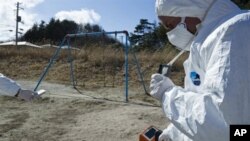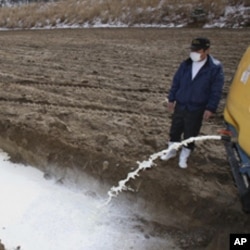As engineers, emergency workers and troops battle to regain control of the Fukushima nuclear power plant, life goes on for thousands of people living just beyond a 20-kilometer evacuation zone. But it is not life as normal.
There is something new on Radio Fukushima. Alongside with the weather and traffic reports, the station has begun delivering hourly radiation reports.
Listen carefully and one place stands out: Iitate
The village is 40 kilometers from the power plant, placing it well outside a 20-kilometer evacuation zone and the area where residents are advised to stay indoors.
But the hourly radiation readings here are higher than many towns closer to the Fukushima nuclear power plant, which was disabled by a massive earthquake and tsunami that hit the area on March 11.
At the entrance of the village hall, a plaque proudly displays Iitate's place as one of Japan's 39 most beautiful villages. Driving in to the town it is hard to ignore the scenic valleys, lush forests and distant mountains that earned the honor.
But look beyond the scenery, and you notice there is no one around. Fields are empty, tractors sit idle, and at the center of the village there is no one on the streets.
A few cars and the odd military truck pass through the intersection in front of the impressive village hall. Most of the drivers and their passengers are wearing white masks across their mouths and noses.
The residents are confused, says Takashi Kobayashi, Iitate's general affairs manager.
Kobayashi says because the village is more than 30 kilometers from the power station, the government has offered no recommendations to residents, but the radiation levels remain high.
Farmers working Iitate's fields would exceed the annual recommended radiation limit in less than a month. Last week the International Atomic Energy Agency said radiation levels in soil topped a limit at which evacuation is advisable, but they have since fallen.
The effect on agriculture is a worry. The village is defined by its farms, and their future is now in doubt.
Kobayashi spends his day coordinating part of Iitate's response to the crisis and watching the news for any change in status at the plant.
He says it is difficult to follow. Something gets better one moment, then something else goes wrong. He says that before the crisis he had never heard of microsieverts and becquerel, the units of radiation measurement that he now spends so much time studying.
On Wednesday, village officials offered to evacuate pregnant women or new mothers who are worried about their health.
About 20 kilometers down the road is Minami Soma. The town of 71,000 people sits in the center of the zone where authorities have recommended people stay inside as much as possible.
Although it is closer to the Fukushima plant, radiation levels are about a tenth those of Iitate. A few people can be seen on the streets, but they do not seem to linger outside for long.
A few weeks ago, the town ran short on food and gasoline. Trucks would not travel within 30 kilometers of the Fukushima plant, so deliveries were disrupted.
The mayor's secretary, Sadayasu Abe, says the mayor took to YouTube to appeal for help, and now the town is managing to get enough supplies.
Abe says a few shops have reopened and gasoline is again available. The city office is distributing relief supplies to residents who can not drive to shops.
Some residents are even returning, feeling life at home beats that of an evacuation shelter.
What the town most wants now, says Abe, is a clean bill of health.
If the town gets that, it will again be able to tell residents that Minami Soma is a safe place to live.
About 70,000 people have evacuated from around the Fukushima plant, and with government warnings that the nuclear crisis could go on for months, the communities nearby face a trying future.











